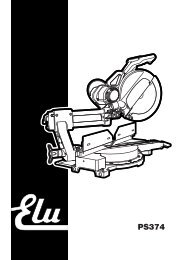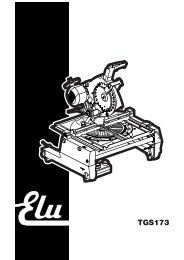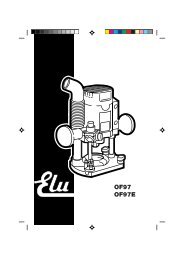Instruction Manual (English) - Service - Dewalt.no
Instruction Manual (English) - Service - Dewalt.no
Instruction Manual (English) - Service - Dewalt.no
You also want an ePaper? Increase the reach of your titles
YUMPU automatically turns print PDFs into web optimized ePapers that Google loves.
www..euD271051
<strong>English</strong> (original instructions) 14Copyright DEWALT2
41A6A7424332A8A93
44144A10A11545352551651BB159 5815 565758 15 565759C1C24
1559C3C460146361 6265 6466DE19192F1F268 6769F3F4705
9887473G1G27673757377 78G3G4H15818079H278276H38383 83H48584 866
I117I282 76 8192791I389 88 90 87J9495K88 93L88 93 96898100207M19997M27
102 10169102M370M44 2 6868 672mm3-8mmM5N12110320104O20N28P1108 107 22
112 111110P2109P3114114P4109 113P5109 11341115116Q1Q2120117827611911841121Q3Q49
122111R1R2124123126111097R3127125S18079819179 80S3S2T110
T2T390°AT4U145°U2U3230°-45°V1V211
13132163128W1W2139 138 139XY1140 141Y2Y312
1 2393Z13
ENGLISHFLIP-OVER SAW D27105Congratulations!You have chosen a DEWALT tool. Years of experience, thorough productdevelopment and in<strong>no</strong>vation make DEWALT one of the most reliablepartners for professional power tool users.Technical dataD27105Type 3Voltage V 115Power input W 1730Power output W 860Max. blade speed min -1 3500Blade diameter mm 305Blade bore mm 30Blade body thickness mm 3.2Riving knife thickness mm 2.5Automatic blade brake time s < 10Weight kg 42Cutting capacitiesMitre saw modeMitre (max. positions) left 48°right 48°Bevel (max. positions) left 48°right 2°Max. crosscut capacity at 90° mm 205Max. mitre cut capacity at 45° mm 160Max. depth of cut 90° mm 90Max. depth of bevel cut 45° mm 60Max. depth of cut at 45° bevel, 45° mitre mm 60Saw bench modeMax. ripping capacity left/right mm 120/320Depth of cut at 90° mm 80Depth of cut at 45° mm 56L PA(sound pressure) dB(A) 95.0K PA(sound pressure uncertainty) dB(A) 3.0L WA(sound power) dB(A) 106.0K WA(sound power uncertainty) dB(A) 3.0Identify additional safety measures to protect the operatorfrom the effects of vibration such as: maintain the tool andthe accessories, keep the hands warm, organisation of workpatterns.Fuses:U.K. & Ireland 115 V tools 16 AmperesNOTE: This device is intended for the connection to a power supply systemwith maximum permissible system impedance Zmax of 0.25 Ω at theinterface point (power service box) of user’s supply.The user has to ensure that this device is connected only to a power systemwhich fulfils the requirement above. If necessary, the user can ask the publicpower supply company for the system impedance at the interface point.Definitions: Safety GuidelinesThe definitions below describe the level of severity for each signal word.Please read the manual and pay attention to these symbols.DANGER: Indicates an imminently hazardous situation which, if<strong>no</strong>t avoided, will result in death or serious injury.WARNING: Indicates a potentially hazardous situation which, if<strong>no</strong>t avoided, could result in death or serious injury.CAUTION: Indicates a potentially hazardous situation which, if<strong>no</strong>t avoided, may result in mi<strong>no</strong>r or moderate injury.NOTICE: Indicates a practice <strong>no</strong>t related to personal injurywhich, if <strong>no</strong>t avoided, may result in property damage.De<strong>no</strong>tes risk of electric shock.De<strong>no</strong>tes risk of fire.EC-Declaration of ConformityD27105DEWALT declares that these products described under “technical data” arein compliance with:2006/42/EC, EN 61029-1, EN 61029-2-11.These products also comply with Directive 2004/108/EC and 2011/65/EU.For more information, please contact DEWALT at the following address orrefer to the back of the manual.The undersigned is responsible for compilation of the technical file andmakes this declaration on behalf of DEWALT.Vibration total values (triax vector sum) determined according to EN 61029:Vibration emission value a ha h = m/s² 2.1Uncertainty K = m/s² 1.5The vibration emission level given in this information sheet has beenmeasured in accordance with a standardised test given in EN 61029 andmay be used to compare one tool with a<strong>no</strong>ther. It may be used for apreliminary assessment of exposure.WARNING: The declared vibration emission level representsthe main applications of the tool. However if the tool is usedfor different applications, with different accessories or poorlymaintained, the vibration emission may differ. This maysignificantly increase the exposure level over the total workingperiod.An estimation of the level of exposure to vibration should alsotake into account the times when the tool is switched off orwhen it is running but <strong>no</strong>t actually doing the job. This maysignificantly reduce the exposure level over the total workingperiod.Horst GrossmannVice President Engineering and Product DevelopmentDEWALT, Richard-Klinger-Straße 11,D-65510, Idstein, Germany01.12.201114
ENGLISHSafety <strong>Instruction</strong>sWARNING! When using electric tools basic safety precautionsshould always be followed to reducethe risk of fire, electric shock and personal injuryincluding the following.Read all these instructions before attempting to operate this product andsave these instructions.SAVE THIS MANUAL FOR FUTURE REFERENCEGeneral Safety Rules1. Keep work area clear.Cluttered areas and benches invite injuries.2. Consider work area environment.Do <strong>no</strong>t expose the tool to rain. Do <strong>no</strong>t use the tool in damp or wetconditions. Keep the work area well lit (250 - 300 Lux). Do <strong>no</strong>t usethe tool where there is a risk of causing fire or explosion, e.g., in thepresence of flammable liquids and gases.3. Guard against electric shock.Avoid body contact with earthed surfaces (e.g., pipes, radiators,cookers and refrigerators). When using the tool under extremeconditions (e.g., high humidity, when metal swarf is being produced,etc.), electric safety can be improved by inserting an isolatingtransformer or a (FI) earth-leakage circuit-breaker.4. Keep other persons away.Do <strong>no</strong>t let persons, especially children, <strong>no</strong>t involved in the work, touchthe tool or the extension cord and keep them away from the work area.5. Store idle tools.When <strong>no</strong>t in use, tools must be stored in a dry place and locked upsecurely, out of reach of children.6. Do <strong>no</strong>t force the tool.It will do the job better and safer at the rate to which it was intended.7. Use the right tool.Do <strong>no</strong>t force small tools to do the job of a heavy duty tool. Do <strong>no</strong>t usetools for purposes <strong>no</strong>t intended; for example do <strong>no</strong>t use circular sawsto cut tree limbs or logs.8. Dress properly.Do <strong>no</strong>t wear loose clothing or jewellery, as these can be caught inmoving parts. Non-skid footwear is recommended when workingoutdoors. Wear protective hair covering to contain long hair.9. Use protective equipment.Always use safety glasses. Use a face or dust mask if workingoperations create dust or flying particles. If these particles might beconsiderably hot, also wear a heat-resistant apron. Wear ear protectionat all times. Wear a safety helmet at all times.10. Connect dust extraction equipment.If devices are provided for the connection of dust extraction andcollecting equipment, ensure these are connected and properly used.11. Do <strong>no</strong>t abuse the cord.Never yank the cord to disconnect it from the socket. Keep thecord away from heat, oil and sharp edges. Never carry the tool by itscord.12. Secure work.Where possible use clamps or a vice to hold the work. It is safer thanusing your hand and it frees both hands to operate the tool.13. Do <strong>no</strong>t overreach.Keep proper footing and balance at all times.14. Maintain tools with care.Keep cutting tools sharp and clean for better and safer performance.Follow instructions for lubricating and changing accessories. Inspecttools periodically and if damaged have them repaired by an authorizedservice facility. Keep handles and switches dry, clean and free from oiland grease.15. Disconnect tools.When <strong>no</strong>t in use, before servicing and when changing accessories suchas blades, bits and cutters, disconnect tools from the power supply.16. Remove adjusting keys and wrenches.Form the habit of checking to see that adjusting keys and wrenches areremoved from the tool before operating the tool.17. Avoid unintentional starting.Do <strong>no</strong>t carry the tool with a finger on the switch. Be sure that the tool isin the “off” position before plugging in.18. Use outdoor extension leads.Before use, inspect the extension cable and replace if damaged.When the tool is used outdoors, use only extension cords intended foroutdoor use and marked accordingly.19. Stay alert.Watch what you are doing. Use common sense. Do <strong>no</strong>t operate the toolwhen you are tired or under the influence of drugs or alcohol.20. Check for damaged parts.Before use, carefully check the tool and mains cable to determinethat it will operate properly and perform its intended function. Checkfor alignment of moving parts, binding of moving parts, breakage ofparts, mounting and any other conditions that may affect its operation.A guard or other part that is damaged should be properly repaired orreplaced by an authorized service centre unless otherwise indicatedin this instruction manual. Have defective switches replaced by anauthorized service centre.Do <strong>no</strong>t use the tool if the switch does <strong>no</strong>t turn it on and off.Never attempt any repairs yourself.WARNING! The use of any accessory or attachment orperformance of any operation with this tool other than thoserecommended in this instruction manual may present a risk ofpersonal injury.21. Have your tool repaired by a qualified person.This electric tool complies relevant safety rules. Repairs should only becarried out by qualified persons using original spare parts; otherwise thismay result in considerable danger to the user.Additional safety rules for mitre saws• Make sure all locking k<strong>no</strong>bs and clamp handles are tight before startingany operation.• Ensure that the machine arm is securely fixed when performing bevelcuts.• Do <strong>no</strong>t operate the machine without the guard in position, or if theguard does <strong>no</strong>t function or is <strong>no</strong>t maintained properly.• Never place either hand in the blade area when the saw is connected tothe electrical power source.• Never attempt to stop a machine in motion rapidly by jamming a tool orother means against the blade; serious accidents can occur.• Select the correct blade for the material to be cut.• Wear suitable gloves when handling saw blade and rough materials.• Never perform any cleaning or maintenance work when the machine isstill running and the head is <strong>no</strong>t in the rest position.• The front section of the guard is louvred for visibility while cutting.Although the louvres dramatically reduce flying debris, there areopenings in the guard and safety glasses should be worn at all timeswhen viewing through the louvres.• Never cut workpiece shorter than 200 mm.• Without additional support the machine is designed to accept themaximum workpiece size of:– Height 63 mm by width 205 mm by length 500 mm– Longer workpieces need to be supported by suitable additionaltable, e.g. DE3474. Always clamp the workpiece safely.• During use in mitre saw mode ensure that the portion of the saw blade,below the table, is completely enclosed by the guard (63) shown inFig. E.Additional safety rules for saw benches• Make sure that the blade rotates in the correct direction and the teethare pointing to the front of the saw bench.• Make sure all locking k<strong>no</strong>bs and clamp handles are tight before startingany operation.15
ENGLISH• Be sure all blade and flanges are clean and the recessed sides of thecollar are against the blade. Tighten the arbor nut securely.• Use correctly sharpened saw blades. Observe the maximum speedmark on the saw blade. The marked maximum speed shall always behigher than the speed marked on rating plate.• Never operate the saw without the upper and lower guards in place.• Never place either hand in the blade area when the saw is connected tothe electrical power source.• Disconnect the saw from the mains before changing blades or carryingout maintenance.• Use a push stick at all times, and ensure that you do <strong>no</strong>t place handscloser than 200 mm from the saw blade while cutting.• Do <strong>no</strong>t attempt to operate on anything but the designated voltage.• Do <strong>no</strong>t apply lubricants to the blade when it is running.• Do <strong>no</strong>t reach around behind the saw blade.• Always keep the push stick in its place when <strong>no</strong>t in use.• Do <strong>no</strong>t stand on top of the unit.• During transportation make sure that the upper part of the saw blade iscovered, e.g. by the guard.• Do <strong>no</strong>t use the guard for handling or transportation.• Rebating, slotting or grooving is <strong>no</strong>t allowed.• Ensure riving knife is adjusted correctly. Never cut without riving knifeassembled.Never cut work-piece smaller than 30 mm.• Without additional support the machine is designed to accept themaximum workpiece size of:– Height 81 mm by width 400 mm by length 600 mm– Longer workpieces need to be supported by suitable additionaltable, e.g. D271055 or D271058.Additional safety rules for flip-over saws• Before using the saw ensure that the machine is stable. Never positionthe machine on uneven ground. If needed secure the machine to aworkbench using 150 mm long hexagon head bolts.• Never operate the machine without the guards in position, especiallyafter a mode change. Keep the guards in good working order andproperly maintained.• Replace table insert when worn.• Ensure that the arm is securely fixed in the working position in thebench sawing mode.• Ensure that the arm is securely fixed when bevelling in the bench sawmode.• Ensure the table is correctly locked when changing the saw mode.• Never saw ferrous or <strong>no</strong>n-ferrous materials when ripping in the benchsaw mode.• Before using any accessory consult the instruction manual. Theimproper use of an accessory can cause damage.• Observe the maximum speed marked on the saw blade.• Wear suitable gloves when handling saw blade and rough materials.• Ensure that the blade rotates in the correct direction. Keep the bladesharp.• The max. allowable speed of the saw blade must always be equal to orgreater than the <strong>no</strong>-load speed of the tool specified on the nameplate.• Do <strong>no</strong>t use saw blades that do <strong>no</strong>t conform to the dimensions statedin the technical data. Do <strong>no</strong>t use any spacers to make a blade fit ontothe spindle. Use only the blades specified in this manual, complyingwith EN 847-1.• Consider applying specially designed <strong>no</strong>ise-reduction blades.• Do <strong>no</strong>t use HIGH SPEED STEEL blades.• Do <strong>no</strong>t use cracked or damaged saw blades.• After completing the cut, release the switch and wait for the saw bladeto come to a complete stillstand before returning the head to its upperrest position.• Ensure that the arm is securely fixed when performing bevel cuts.• Do <strong>no</strong>t wedge anything against the fan to hold the motor shaft.• The blade guard on your saw will automatically raise when the arm isbrought down; it will lower over the blade when the arm is raised.The guard can be raised by hand when installing or removing sawblades or for inspection of the saw. Never raise the blade guardmanually unless the saw is switched off.• Keep the surrounding area of the machine well maintained and free ofloose materials, e.g. chips and cut-offs.• Check periodically that the motor air slots are clean and free of chips.• Disconnect the machine from the mains before carrying out anymaintenance work or when changing the blade.• Use only saw blades specified by the manufacturer. Ensure that theriving knife is <strong>no</strong>t thicker than the width of the groove cut by the sawblade and <strong>no</strong>t thinner than the body of the saw blade.• Make sure the machine is placed on an even surface with sufficientstability.• Do <strong>no</strong>t use abrasive or diamond disc.• In case of an accident or machine failure immediately switch themachine off and disconnect from power source.Report the failure and mark the machine in suitable form to preventsother persons from use the defective machine.• When the saw blade is blocked due to ab<strong>no</strong>rmal feed force duringcutting, turn the machine off and disconnect it from power supply.Remove the workpiece and ensure that the saw blade runs free. Turnthe machine on and start new cutting operation with reduced feedforce.• Refrain from removing any cut-offs or other parts of the workpiece fromthe cutting area while the machine is running and the saw head is <strong>no</strong>t inthe rest position• Do <strong>no</strong>t use the machine without the legs mounted.• Make sure your position is always left or right of the cutting line.• Provide adequate general or localized lighting.• Ensure the operator is adequately trained in the use, adjustment andoperation of the machine.• Switch the machine off when unattended.• A laser to indicate the cutting line is supplied with the D27107V, thelaser is of class 2 according to EN 60825-1. Do <strong>no</strong>t replace a laserdiode with a different type. If damaged, have the laser repaired by anauthorised repair agent.• Connect the saw to a dust collection device when sawing wood.Always consider factors which influence exposure of dust such as:-– type of material to be machined (chip board produces more dustthan wood);-– sharpness of the saw blade;-– correct adjustment of the saw blade,-– dust extractor with air velocity <strong>no</strong>t less than 20 m/s.Ensure that the local extraction as well as hoods, baffles and chutes areproperly adjusted.• Never cut light alloy, especially magnesium.Residual risksThe following risks are inherent to the use of saws:- injuries caused by touching the rotating partsIn spite of the application of the relevant safety regulations and theimplementation of safety devices, certain residual risks can<strong>no</strong>t be avoided.These are:- Impairment of hearing.- Risk of accidents caused by the uncovered parts of the rotating sawblade.- Risk of injury when changing the blade.- Risk of squeezing fi ngers when opening the guards.- Health hazards caused by breathing dust developed when sawingwood, especially oak, beech and MDF.The following factors are of infl uence to <strong>no</strong>ise production:• The material to be cut16
ENGLISH• The type of saw blade• The feed forceThe following factors increase the risk of breathing problems:• No dust extractor connected when sawing wood• Insuffi cient dust extraction caused by uncleaned exhaust fi lters• Worn saw blade• Workpiece <strong>no</strong>t exactly guidedMarkings on ToolThe following pictograms are shown on the tool:Read instruction manual before use.Wear ear protection.Wear eye protection.• Check for damage to the tool, parts or accessories which may haveoccurred during transport.• Take the time to thoroughly read and understand this manual prior tooperation.Description (fig. A1 - A11)A11 On/off switch (saw bench mode)2 Table release lever3 Rotating table clamp4 Mitre saw table5 Rotating table6 Fence right-hand side7 Fence left-hand side8 Moveable lower blade guard9 Guard release lever10 Operating handle142 Circuit breaker reset button143 Date codeO/ICarrying PointHands AwayWhen using the machine in the mitre saw mode, makesure to operate the trigger switch in the handle whenswitching ON and OFF. Do <strong>no</strong>t operate the switchboxin this mode. The ON/OFF switch located to machineframe is foreseen for table saw mode only.When using the machine in the mitre saw mode, makesure the riving knife is secured in its rest position.Never use as mitre saw when the guard is <strong>no</strong>t in place.A210 Operating handle11 Trigger switch (mitre saw mode)12 Fixed upper blade guard13 Dust extraction adapter14 Wheel15 Leg16 Foot17 Bevel clamp handleA317 Bevel clamp handle18 Height adjuster19 Saw bench table20 Riving knife21 Upper blade guard22 Parallel fence23 Push stickOptional accessoriesA4For use in mitre saw mode:30 Fence insert (DE7120)DATE CODE POSITION (FIG. A1)The Date Code (143), which also includes the year of manufacture, is printedinto the housing.Example:2012 XX XXYear of ManufacturePackage ContentsThe package contains:1 Partly assembled machine1 Box containing:1 Top guard for bench saw position1 Under-table guard for mitre saw position4 Legs2 Wheels4 Feet1 Parallel fence1 Material clamp1 <strong>Instruction</strong> manual1 Exploded drawingA531 Adjustable stand 760 mm (max. height) (DE3474)32 Support guide rails 1,000 mm (DE3494)33 Support guide rails 500 mm (DE3491)34 Inclinable support (DE3495)35 Swivelling stop (DE3462)36 Length stop for short workpieces (to be used with guide rails [33])(DE3460)37 Support with removable stop (DE3495)38 Support with stop removed (DE3495)A640 Roller support table (DE3497)For use in saw bench mode:A741 Mitre fence (D271052)A842 Extension table (D271058)17
ENGLISHA943 Sliding table (D271055)Push sticks (DE3454) (<strong>no</strong>t shown)For use in all modes:A1044 Three way dust extraction kit (D271054)A11144 LaserINTENDED USEYour DEWALT D27105 flip-over saw has been designed to operate as amitre saw or a saw bench to perform the four main sawing operations ofripping, cross-cutting, bevelling and mitring easily, accurately and safely.This unit is designed for use with a <strong>no</strong>minal blade diameter 305 mm carbidetip blade for professional cutting wood, wood products and plastics.DO NOT use under wet conditions or in presence of flammable liquids orgases.These flip over saws are professional power tools.DO NOT let children come into contact with the tool. Supervision is requiredwhen inexperienced operators use this tool.WARNING! Do <strong>no</strong>t use the machine for purposes other thanintended.• This product is <strong>no</strong>t intended for use by persons (including children)suffering from diminished physical, sensory or mental abilities; lack ofexperience, k<strong>no</strong>wledge or skills unless they are supervised by a personresponsible for their safety. Children should never be left alone with thisproduct.Mitre saw modeIn mitre saw mode, the sawing machine is used in vertical, mitre or bevelposition.Saw bench modeTurned over on its central axis, the sawing machine is used to performthe standard ripping operation and for sawing wide pieces by manuallyfeeding the workpiece into the blade.Electrical SafetyThe electric motor has been designed for one voltage only. Always checkthat the power supply corresponds to the voltage on the rating plate.Your tool is double insulated in accordance with EN 61029;therefore <strong>no</strong> earth wire is required.WARNING: 115 V units have to be operated via a fail-safeisolating transformer with an earth screen between the primaryand secondary winding.In case of cord replacement the tool must only be repaired by an authorizedservice agent or by qualified electrician.Fitting a Mains Plug to 115 V Units(U.K. and Ireland Only)• The plug fitted should be comply with BS EN 60309 (BS4343),16 Amps, earthing contact position 4h.WARNING: Always ensure that the cable clamp is correctly andsecurely fitted to the sheath of the cable.Using an Extension CableIf an extension cable is required, use an approved 3–core extension cablesuitable for the power input of this tool (see Technical Data).The minimumconductor size is 1.5 mm 2 ; the maximum length is 30 m.When using a cable reel, always unwind the cable completely.ASSEMBLYWARNING: To reduce the risk of injury, turn unit off anddisconnect machine from power source before installingand removing accessories, before adjusting or changingset-ups or when making repairs. Be sure the trigger switchis in the OFF position. An accidental start-up can cause injury.Unpacking the machine and its parts.WARNING: To reduce the risk of injury, always seek assistancewhen moving the machine.• Remove the loose packaging material from the box.• Lift the machine out of the box.• Remove the parts box from the interior of the machine.• Remove any remaining packing material from the machine.Mounting the feet (fig. B, B1)With the feet and legs mounted, alternatively the machine is suitable forplacement on a workbench. To ensure a safe operation, the machine mustbe fastened to the workbench.WARNING! Do never operate this machine when it is <strong>no</strong>tfastened to the workbench. The feed force will make the sawunstable if <strong>no</strong>t fastened to the workbench.• Turn the machine upside down• Place a foot (16) on each of the mounting locations (51) on the base• Slide a nut (52) into the slots (53) located above the mounting locations• Insert a bolt (54) fitted with a washer (55) into the feet• Tighten the bolts• Mount the legs as described below.• Fold the legs as described below• Turn the machine straight up• Insert a bolt of 8 mm and 120 mm minimum length (49) into the feet oneach mounting location (fig. B1).• Tighten the boltsMounting the legs (fig. C1 & C2)With the legs mounted, the machine is suitable for stand-alone placement.• Turn the machine upside down.• Mount the legs as described below. Beware that the front legs and therear legs have different lengths. The rear legs are slightly longer thanthe front legs. Make sure to mount the legs in the correct place.• Turn the machine straight up. Make sure it is level; adjust the legclamping height if required.Rear legs• Present a leg (15) to each of the mounting points (56) located at thelower edges on the inside of the base (fi g. C1).• Pass a coach bolt (57) from the outside through the holes into theframe and the legs.• Place a bracket (58) and a lock k<strong>no</strong>b (59) onto the bolts.• Tighten the lock k<strong>no</strong>bs.Front legs• Present a leg (15) to each of the mounting points (56) located at theupper edges on the inside of the base (fi g. C2).• Place a bracket (58) over the legs.• Pass a coach bolt (57) from the inside through the holes into thebrackets, the legs and frame.• Place a lock k<strong>no</strong>b (59) onto the bolts.• Tighten the lock k<strong>no</strong>bs.Folding the legs (fig. C3, C4)/Bench mounting (fig. B1)The legs can be folded into the base to make the machine suitable for useon a workbench.18
ENGLISH• Turn the machine upside down• Loosen the lock k<strong>no</strong>b (59) of the first leg (15)• Fold the leg inwards• Tighten the lock k<strong>no</strong>b• Repeat as for the other legs• Turn the machine straight up• Use both holes (49) in the legs and secure the machine with bolts witha diameter of 8 mm and minimum 150 mm length.To prevent binding and inaccuracy, be sure the mounting surface is <strong>no</strong>twarped or otherwise uneven.Mounting the wheels (fig. D)• Place a wheel (14) onto the axles (60) on each side of the machine.• Place a fl at washer (61) and a nut (62) onto the threaded end of the axles.• Tighten the nuts using the spanner supplied.Assembly for mitre saw modeMounting the under-table guard (fig. E)The under-table guard (63) is fi tted to the top of the saw bench table.• Place the two fasteners on the left of the guard into the slots (64) onthe left of the blade slot (65). Turn the plastic screws counterclockwise.• Place the guard fl at on the table and press the fastener in the slot (66)on the right of the blade slot. Turn the plastic screw counterclockwise.• To remove, turn the screws clockwise and remove the guard.Turning the sawhead and table over (fig. F1 - F4)• Withhold the saw table (19) with one hand and push the table releaselever (2) to the right (fi g. F1).• Push the table downwards at the front (fi g. F2) and swing it overcompletely until the motor assembly is uppermost and the plate (67)engages in the table locking device (68) (fi g. F3).• Push the release lever (69) to the rear whilst holding down the headuntil the spring-loaded bearing unit (70) can be lifted out of its seating(fi g. F4).• Flip the bearing unit up.• Holding the head fi rmly, allow the spring pressure to take the headupwards into its rest position.Mounting the saw blade (fig. G1 - G4)WARNING: To reduce the risk of injury, turn unit off anddisconnect machine from power source before installingand removing accessories, before adjusting or changingset-ups or when making repairs. Be sure the trigger switchis in the OFF position. An accidental start-up can cause injury.• Always change blades with the machine in mitre saw mode.• Never depress the spindle lock button while the blade is underpower or coasting.• Do <strong>no</strong>t cut ferrous metal (containing iron or steel) or masonry orfibre cement product with this mitre saw.• The teeth of a new blade are very sharp and can be dangerous.• Always change blades with the machine in mitre mode.• Depress the head lock up release lever (9) to release the lowerguard (8),then raise the lower guard as far as possible (Fig. G1).• With the lower guard held in the raised position, depress the spindlelock button (74) with one hand, then use the supplied blade spannerin the other hand to loosen the left-hand threaded blade locking screw(73) by turning clockwise.WARNING! To use the spindle lock, press the button as shownand rotate the spindle by hand until you feel the lock engage.Continue to hold the lock button in to keep the spindle from turning (74,fig. G1).• Remove the blade locking screw (73) and the outside arbor collar (75).• Install the saw blade (76) onto the shoulder (77) provided on theinside arbor collar (78), making sure that the teeth at the bottom edgeof the blade are pointing toward the back of the saw (away from theoperator).• Replace the outer arbor collar (75).• Tighten the blade locking screw (73) carefully by turning counterclockwisewhile holding the spindle lock engaged with your other hand.• Raise the lower guard.WARNING! Be aware the saw blade shall be replaced in thedescribed way only. Only use saw blades as specified underTechnical Data; Cat.<strong>no</strong>.: DT4260 is suggested.Adjustments for mitre saw modeYour mitre saw was accurately adjusted at the factory. If readjustment dueto shipping and handling or any other reason is required, follow the stepsbelow to adjust your saw. Once made, these adjustments should remainaccurate.Checking and adjusting the blade to the fence (fig. H1 - H3)• Loosen the mitre k<strong>no</strong>b (79) and depress the mitre latch (80) to releasethe rotating table (5) (fi g. H1).• Swing the rotating table until the latch locates it at the 0° mitre position.Do <strong>no</strong>t tighten the k<strong>no</strong>b.• Pull down the head until the blade just enters the saw kerf (81).• Place a square (82) against the left side (7) of the fence and blade (76)(fi g. H2).WARNING: Do <strong>no</strong>t touch the tips of the blade teeth with thesquare.• If adjustment is required, proceed as follows:• Loosen the screws (83) (fi g. H3) and move the scale/rotating tableassembly left or right until the blade is at 90° to the fence as measuredwith the square (fi g. H2).• Retighten the screws (83) (fi g. H3). Pay <strong>no</strong> attention to the reading ofthe mitre pointer at this point.Adjusting the mitre pointer (fig. H1 & H4)• Loosen the mitre k<strong>no</strong>b (79) and depress the mitre latch (80) to releasethe rotating table (5) (fi g. H1).• With the mitre k<strong>no</strong>b loose, allow the mitre latch to snap into place asyou rotate the mitre arm past zero.• Observe the pointer (84) and mitre scale (85) (fi g. H4). If the pointerdoes <strong>no</strong>t indicate exactly zero, loosen the screw (86), move the pointerto read 0° and tighten the screw.Checking and adjusting the blade to the table (fig. I1 - I3)• Loosen the bevel clamp k<strong>no</strong>b (17) (fi g. I1).• Press the saw head to the right to ensure it is fully vertical and tightenthe bevel clamp handle.• Pull down the head until the blade just enters the saw kerf (81).• Place a set square (82) on the table and up against the blade (76) (fi g. I2).WARNING: Do <strong>no</strong>t touch the tips of the blade teeth with thesquare.• If adjustment is required, proceed as follows:• Loosen the bevel clamp k<strong>no</strong>b (17) (fi g. I1) and turn the vertical positionadjustment stop screw (87) (fi g. I3) in or out until the blade is at 90° tothe table as measured with the square (fi g. I2).• If the bevel pointer (88) does <strong>no</strong>t indicate zero on the bevel scale (89),loosen the screw (90) that secures the pointer and move the pointer asnecessary (fi g. I3).19
ENGLISHAdjusting the fence (fig. J)The upper part of the left side of the fence can be adjusted to the left toprovide clearance, allowing the saw to bevel to a full 48° left. To adjust thefence (7):• Loosen the fence clamping k<strong>no</strong>b (91) and slide the upper part of theside fence to the left.• Make a dry run with the saw switched off and check for clearance.Adjust the fence to be as close to the blade as practical to providemaximum workpiece support, without interfering with the up and downmovement of the arm.• Tighten the k<strong>no</strong>b securely.WARNING: The guide groove (92) can become clogged withsawdust. Use a stick or some low pressure air to clear the guidegroove.Checking and adjusting the bevel angle (fig. I1, J, K & L)• Loosen the fence clamping k<strong>no</strong>b (91) and slide the upper part of theside fence to the left as far as it will go (fi g. J).• Loosen the bevel clamp k<strong>no</strong>b (17) (fi g. I1) and with the intermediatebevel position stop (93) turned aside move the saw arm to the left untilthe angle position stop (94) rests against the bevel position adjustmentstop (95) (fi g. K). This is the 45° bevel position.• If adjustment is required, proceed as follows:• Turn the bevel position adjustment stop screw (95) in or out asnecessary until the pointer (88) indicates 45° with the angle positionstop resting against the bevel position adjustment stop.Checking and adjusting the intermediate bevel angle (fig. I1, J & L)The intermediate bevel angle is preset at 30°, enabling a quick setting forthe cutting of crown moulding.• Loosen the fence clamping k<strong>no</strong>b (91) and slide the upper part of theside fence to the left as far as it will go (fi g. J).• Loosen the bevel clamp k<strong>no</strong>b (17) (fi g. I1) and with the intermediatebevel position stop (93) turned into place move the saw arm to the leftuntil the angle position adjustment stop (96) rests on the intermediatebevel position stop (93) (fi g. L). This is the 30° bevel position.• If adjustment is required, proceed as follows:• Turn the bevel position adjustment stop screw (96) in or out asnecessary until the pointer (88) indicates 30° with the bevel positionadjustment stop resting on the intermediate bevel position stop.Assembly for saw bench modeChanging from mitre saw to saw bench mode (fig. A1, M1 - M5)• Put the blade into 0° cross-cut position with the rotating table clamp (3)secured (fi g. A1).• Slacken the riving knife clamp k<strong>no</strong>b (97) just e<strong>no</strong>ugh to allow the rivingknife to enter the mounting slot (fi g. M1).• Remove the riving knife (20) from its storage position in the inside of thebase.• Depress the guard release lever (9) to release the blade guard (8),then raise the blade guard as far as possible (fi g. A1).• Slide the riving knife bracket (98) into the mounting slot (99) (fi g. M1).Tighten the clamp k<strong>no</strong>b.• Push the lever (100) to allow the spring loaded upper part of the fence (7)to rest against the rotating table (fi g. M2)• Pull down the sawhead.• Push the release lever (69) to the rear (fi g. M3).• Push the bearing unit (70) down until <strong>no</strong>tches (101) engage in thelocations (102) (fi g. M3).WARNING: The blade should <strong>no</strong>t foul the lower blade guard.• Pull the table release lever (2) to the right, lift the front edge of the table(4) fi g. M4) and fl ip it back through 180° until the plate of the tablelockingdevice (68) automatically engages the latch of the table lockingdevice to secure it in the saw bench mode (fi g. M5).• Remove the under-table guard.Adjusting the riving knife (fig. N1 & N2)WARNING: When adjustments to the riving knife (20) are to bemade, it is best to rotate the unit in mitre saw mode (fig. N2).Proceed as described in the section “Changing from saw benchto mitre saw mode”.The correct position is for the top of the riving knife to be <strong>no</strong> more than 2 mmbelow the highest tooth of the blade and the body of the radius to be amaximum of 3 - 8 mm from the tips of the saw blade teeth (fi g. N1).• If adjustment is required, proceed as follows:• Slacken the bolts (104) to adjust the horizontal position of the riving knife.• Slacken the bolts (103) to adjust the vertical position of the riving knife.• Securely tighten the bolts.Fitting the upper blade guard (fig. O)The upper blade guard (21) is designed to be quickly and easily attachedto the riving knife (20) once the machine has been set up for saw bench mode.• Holding the guard vertically, align the slot in the rear of the guard withthe riving knife.• Lower the guard over the riving knife (20), making sure that the shaft ofthe bolt enters the recess.• Turn the guard into horizontal position.WARNING: Never use your saw in saw bench mode withoutthe upper guard correctly fitted.Mounting and adjusting the parallel fence (fig. P1 - P5)The parallel fence (22) can be mounted on either side of the blade.• Slide the bracket (107) on from the left or the right (fi g. P1).The clamping plate engages behind the front edge of the table.• Slide the fence up against the blade.• Push the lever (108) down to secure the fence in place.• Check that the fence is parallel to the blade.• If adjustment is required, proceed as follows:• Loosen the lock k<strong>no</strong>bs (109) and slide the fence backwards in order toobtain access to the adjustment bolts (110) in the top of the fence (fi g. P2).• Using the spanner, loosen the adjustment bolts fastening the fencebracket to the fence support.• Adjust the fence so that it is parallel to the blade by checking thedistance between the blade and the fence at the front and rear of theblade.• When the adjustment has been carried out, re-tighten the adjustmentbolts and check again that the fence is parallel to the blade.• Check that the pointer (111) indicates zero on the scale (fi g. P3). If thepointer does <strong>no</strong>t indicate exactly zero, loosen the screw (112),move the pointer to read 0° and tighten the screw.The default set-up of the fence is to the right-hand side of the blade.To prepare the fence for use to the left-hand side of the blade, proceed asfollows (fi g. P4):• Remove the lock k<strong>no</strong>bs (109).• Slide the fence profi le (113) out of the clamping support.• Turn the clamping support (114) round and re-fi t the lock k<strong>no</strong>bs.• Slide the fence onto the clamping support.• Tighten the k<strong>no</strong>bs.The fence is reversible: the workpiece can be guided along the 75 mm oralong the 11 mm face to allow the use of a push stick when ripping thinworkpieces (fi g P5).20
ENGLISH• To set for 11 mm, loosen the fence clamping k<strong>no</strong>bs (109) and slide thefence (113) out of the clamping support (114).• Turn the fence and re-engage the clamping support in the slot asshown (fi g. P5).• To use with the full height of 75 mm, slide the fence into the clampingsupport with the wide face in the vertical position (fi g. P4).WARNING: Use the 11 mm profile for ripping low workpiecesto allow access between the blade and the fence for the pushstick. The rear end of the fence should be level with the front ofthe riving knife.Mounting and adjusting the mitre fence (fig. Q1 - Q4)The mitre fence (D271052) is available as an option. The mitre fence (41) canbe used for mitre cutting when the machine is in saw bench mode (fi g. Q1).• Loosen the clamp k<strong>no</strong>b (115) and swing the guide bar (116) out (fi g. Q2).Tighten the clamp k<strong>no</strong>b.• Slide the fence on the left side on the table (fi g. Q3).• Loosen the lock k<strong>no</strong>b (117).• Place a square (82) against the fence (41) and the blade (76).• If adjustment is required, proceed as follows:• Loosen the nut (118) a few turns and turn the right angle adjustmentstop screw (119) (fi g. Q4) in or out until the fence is at 90° to the bladeas measured with the square (fi g. Q3).• Tighten the k<strong>no</strong>b (117).• Check that the pointer (120) indicates zero on the scale (121).Adjust if necessary.Changing from saw bench to mitre saw mode (fig. A3, E & M1)• Remove the parallel fence (22), or the mitre fence, if fi tted (fi g. A3).• Remove the upper blade guard (21).• Replace the under-table guard (63) (fi g. E).• Proceed as described in the section “Turning the sawhead and tableover”.• Slacken the riving knife clamp k<strong>no</strong>b (97) and remove the riving knife (20),while holding the blade guard (8) (fi g. M1).• Lower the blade guard.• Place the riving knife in its storage position in the inside of the base.OPERATION<strong>Instruction</strong>s for UseWARNING: Always observe the safety instructions andapplicable regulations.• Ensure the material to be sawn is firmly secured in place.• Apply only a gentle pressure to the tool and do <strong>no</strong>t exert sidepressure on the saw blade.• Avoid overloading.The attention of UK users is drawn to the “woodworking machinesregulations 1974” and any subsequent amendments.Ensure the machine is placed to satisfy your ergo<strong>no</strong>mic conditions in termsof table height and stability. The machine site shall be chosen so that theoperator has a good overview and e<strong>no</strong>ugh free surrounding space aroundthe machine that allows handling of the workpiece without any restrictions.To reduce effects of vibration make sure the environment temperature is <strong>no</strong>ttoo cold, machine and accessory is well maintained and the workpiece sizeis suitable for this machine.Prior to operation:• Install the appropriate saw blade. Do <strong>no</strong>t use excessively worn blades.The maximum rotation speed of the tool must <strong>no</strong>t exceed that of thesaw blade.• Do <strong>no</strong>t attempt to cut excessively small pieces.• Allow the blade to cut freely. Do <strong>no</strong>t force.• Allow the motor to reach full speed before cutting.• Make sure all locking k<strong>no</strong>bs and clamp handles are tight.Switching on and off (fig. A1, R1 - R3)This machine has two independent switching systems. In mitre saw mode,the trigger switch (11) is used (fi g. R1). In saw bench mode, the on/offswitch (1) is used (fi g. R2). Integrated in the switch box is a motor overloadprotector with manual reset. In case of a power shut-off, proceed asfollows:- Make sure the machine has been switched off.- Press the reset button (142).Mitre saw mode (fig. R1)A hole (122) is provided in the trigger for insertion of a padlock to lock theswitch.• To run the tool, press the trigger switch (11).• To stop the tool, release the switch.Saw bench mode (fig. R2 & R3)The on/off switch offers multiple advantages:- <strong>no</strong>-volt release function: should the power be shut off for some reason,the switch has to be deliberately reactivated.- extra safety: the hinged safety enclosure plate (123) can be locked bypassing a padlock through the holes (124 & 125). The plate also servesas an “easy to locate” emergency stop button as pressure on the frontof the plate will depress the stop button.• To switch the machine on, press the green start button (126).• To switch the machine off, press the red stop button (127).Locking the switches• In order to avoid unauthorised use of the machine, lock both switchesusing padlocks.Basic saw cutsSawing in mitre saw modeIt is dangerous to operate without guarding. Guards must be in positionwhen sawing.• Make sure that the under-table guard does <strong>no</strong>t become clogged withsawdust.• Always clamp the workpiece when cutting <strong>no</strong>n-ferrous metals.General handling- In the mitre saw mode, the sawhead is automatically locked in theupper “park”-position.- Squeezing the guard release lever will unlock the sawhead. Moving thesawhead down retracts the movable lower guard.- Never seek to prevent the lower guard returning to its park positionwhen the cut is completed.- The minimum length of offcut material is 10 mm.- When cutting short material (min. 190 mm to the left or the right of theblade), the use of the optional material clamp is recommended.- When cutting UPVC sections, a supporting piece made out of timberwith a complementary profi le should be placed beneath the materialbeing cut to provide the correct level of support.Clamping the Workpiece (fig. A5, Z)WARNING: A workpiece that is clamped, balanced and securebefore a cut may become unbalanced after a cut is completed.An unbalanced load may tip the saw or anything the saw isattached to, such as a table or workbench. When making a cutthat may become unbalanced, properly support the workpieceand ensure the saw is firmly bolted to a stable surface. Personalinjury may occur.WARNING: The clamp foot must remain clamped above thebase of the saw whenever the clamp is used. Always clamp theworkpiece to the base of the saw – <strong>no</strong>t to any other part of thework area. Ensure the clamp foot is <strong>no</strong>t clamped on the edge ofthe base of the saw.21
ENGLISHCAUTION: Always use a work clamp to maintain control andreduce the risk of workpiece damage and personal injury, if yourhands are required to be within 160 mm of the blade during thecut.Use the material clamp (39) provided with your saw. Other aids such asspring clamps, bar clamps or C-clamps may be appropriate for certain sizesand shapes of material. The left or right fence will slide from side to side toaid in clamping.TO INSTALL CLAMP1. Insert it into the hole behind the fence. The clamp should be facingtoward the back of the mitre saw. Ensure the groove on the clamp rodis fully inserted into the base of the mitre saw. If the groove is visible, theclamp will <strong>no</strong>t be secure.2. Rotate the clamp 180º toward the front of the mitre saw.3. Loosen the k<strong>no</strong>b to adjust the clamp up or down, then use the fineadjust k<strong>no</strong>b to firmly clamp the workpiece.NOTE: Place the clamp on the right side of the fence when beveling.ALWAYS MAKE DRY RUNS (UNPOWERED) BEFORE FINISH CUTS TOCHECK THE PATH OF THE BLADE. ENSURE THE CLAMP DOES NOTINTERFERE WITH THE ACTION OF THE SAW OR GUARDSVertical straight cross cut (fig. S1)• Loosen the mitre k<strong>no</strong>b (79) and depress the mitre latch (80).• Engage the mitre latch at the 0° position and tighten the mitre k<strong>no</strong>b.• Place the wood to be cut against the fence (7).• Take hold of the operation handle (10) and press in the guard releaselever (9).• Press the trigger switch (11) to start the motor.• Depress the head to allow the blade to cut through timber and enterthe saw kerf (81).• After completing the cut, release the switch and wait for the saw bladeto come to a complete stillstand before returning the head to its upperrest position.Vertical mitre cross-cut (fig. S2)• Loosen the mitre k<strong>no</strong>b (79) and depress the mitre latch (80). Move therotating table left or right to the required angle.• The mitre latch will automatically locate at 15°, 22.5°, 35.3° and 45°both left and right. If any intermediate angle is required hold the headfi rmly and lock by tightening the mitre k<strong>no</strong>b.• Always ensure that the mitre k<strong>no</strong>b is locked tightly before cutting.• Proceed as for a vertical straight cross-cut.WARNING: When mitring the end of a piece of wood with asmall off-cut, position the wood to ensure that the off-cut is tothe side of the blade with the greater angle to the fence:left mitre, off-cut to the rightright mitre, off-cut to the left.Bevel cross-cut (fig. A2, S3)Bevel angles can be set from 48° left to 2° right and can be cut with therotating table set between zero and a maximum of 45° mitre position leftor right.• Loosen the fence clamping k<strong>no</strong>b (91) and slide the upper part of theside fence to the left as far as it will go.• Loosen the bevel clamp k<strong>no</strong>b (17) and set the bevel as desired.• Tighten the bevel clamp k<strong>no</strong>b fi rmly.• Proceed as for a vertical straight cross-cut.Compound mitre (fig T1 - T4)A compound mitre is a cut made using a mitre angle (fi g. T1) and a bevelangle (fi g. T2) at the same time. This is the type of cut used to makeframes or boxes with slanting sides like the one shown in fi g. T3.WARNING: If the cutting angle varies from cut to cut, checkthat the bevel clamp k<strong>no</strong>b and the mitre lock k<strong>no</strong>b are securelytightened. These k<strong>no</strong>bs must be tightened after making anychanges in bevel or mitre.• The chart shown below will assist you in selecting the proper beveland mitre settings for common compound mitre cuts. To use the chart,select the desired angle “A” (fi g. T4) of your project and locate thatangle on the appropriate arc in the chart. From that point follow thechart straight down to fi nd the correct bevel angle and straight acrossto fi nd the correct mitre angle.• Set your saw to the prescribed angles and make a few trial cuts.• Practice fi tting the cut pieces together.• Example: To make a 4 sided box with 25° exterior angles (angle “A”)(fi g. T4), use the upper right arc. Find 25° on the arc scale. Follow thehorizontal intersecting line to either side to get the mitre angle settingon the saw (23°). Likewise follow the vertical intersecting line to the topor bottom to get the bevel angle setting on the saw (40°). Always trycuts on a few scrap pieces of wood to verify the settings on the saw.SET THIS MITER ANGLE ON SAW8 SIDED BOX6 SIDED BOXSQUARE BOXSET THIS BEVEL ANGLE ON SAWCutting base mouldingsThe cutting of base moulding is performed at a 45° bevel angle.• Always make a dry run without power before making any cuts.• All cuts are made with the back of the moulding laying fl at on the saw.Inside corner- Left side• Position the moulding with top of the moulding against the fence.• Save the left side of the cut.- Right side• Position the moulding with the bottom of the moulding against thefence.• Save the left side of the cut.Outside corner- Left side• Position the moulding with the bottom of the moulding against thefence.• Save the right side of the cut.- Right side• Position the moulding with top of the moulding against the fence.• Save the right side of the cut.ANGLE OF SIDE OF BOX (ANGLE"A")22
ENGLISHCutting crown mouldingsThe cutting of crown moulding is performed in a compound mitre. I<strong>no</strong>rder to achieve extreme accuracy, your saw has pre-set angle positionsat 35.3° mitre and 30° bevel. These settings are for standard crownmouldings with 45° angles at the top and 45° angles at the bottom.• Make test cuts using scrap material before doing the fi nal cuts.• All cuts are made in a left bevel and with the back of the mouldingagainst the base.Inside corner- Left side• Top of the moulding against the fence.• Mitre right.• Save the left side of the cut.- Right side• Bottom of the moulding against the fence.• Mitre left.• Save the left side of the cut.Outside corner- Left side• Bottom of the moulding against the fence.• Mitre left.• Save the right side of the cut.- Right side• Top of the moulding against the fence.• Mitre right.• Save the right side of the cut.Sawing in the bench mode• Always use the riving knife.• Always ensure that the riving knife and blade guard are correctlyaligned.• Always ensure that the mitre saw is set and locked in 0° mitre.WARNING: Do <strong>no</strong>t cut metal in this mode.Ripping (fig. U1 & U3)• Set the bevel angle to 0°.• Adjust the saw blade height.• Set the parallel fence to the required distance.• Hold the workpiece fl at on the table and against the fence. Keep theworkpiece approx. 25 mm away from the saw blade.• Keep both hands away from the path of the saw blade.• Switch the machine on and allow the saw blade to reach full speed.• Slowly feed the workpiece underneath the upper blade guard, keepingit fi rmly pressed against the fence. Allow the teeth to cut, and do <strong>no</strong>tforce the workpiece through the saw blade. The saw blade speedshould be kept constant.• Remember to use the push stick (23) when close to the blade.• After completing the cut, switch the machine off, allow the saw bladeto stop and remove the workpiece.WARNING: Never push or hold the free or cut-off side of theworkpiece.WARNING: Always use a push stick when ripping smallworkpieces.Bevel cuts (fig. U2)• Set the required bevel angle.• Proceed as for ripping.Cross-cutting (fig. V1)• Set the bevel angle to 0°.• Adjust the saw blade height.• Set the mitre fence to 0°.• Proceed as for ripping, only use the mitre fence to push the workpiecethrough the blade.Bevel cross-cutting• Set the required bevel angle.• Proceed as for cross-cutting.Mitre cuts (fig. V2)• Set the mitre fence to the required angle.• Proceed as for cross-cutting.Optional attachmentsWARNING: Prior to assembling any accessories always unplugthe machine.Dust extraction kit (fig. W1 & W2)WARNING! This machine is provided with two dust extractionpoints for use in each mode.WARNING! Whenever possible, connect a dust extractiondevice designed in accordance with the relevant regulationsregarding dust emission.WARNING! When sawing wood, connect a dust extractiondevice designed in accordance with the relevant regulationsregarding dust emission.Connect a dust collection device designed in accordance with the relevantregulations. The air velocity of externally connected systems shall be 20m/s ±2 m/s. Velocity to be measured in the connection tube at the point ofconnection, with the tool connected but <strong>no</strong>t running.tion tube at the point ofconnection, with the tool connected but <strong>no</strong>t running.Connecting - mitre saw position (fig. W1)• Connect the one end of the fi rst hose to the dust extraction adaptor (13).• Insert the other end of the hose into the middle inlet port of themanifold (128).• Connect the one end of the other hose to the under-table guard (63).• Insert the other end of the hose into the outer inlet port of the manifold.Connecting - saw bench position (fig. W2)• Proceed as for mitre saw position, only connect the hose from theunder-table guard to the saw blade guard (21).Mitre saw extra support/length stop (fig. A5)The extra support and length stop can be mounted on the left-hand sideor on the right-hand side, or with two sets on either side.• Fit the items 31 - 39 onto the two guide rails (32 & 33).• Use the inclinable support (34) for cross-cutting 210 mm wide boards(15 mm thick).Roller support table (fig. A6)The roller support table (40) is used to support long workpieces. In mitresaw mode, the roller support table can be mounted on the left-hand sideor on the right-hand side, or with two sets on either side. In saw benchmode, it can also be mounted in front or at the rear of the saw table.Side extension table (fig. A8)The side extension table increases the distance from the rip fence tothe blade to 600 mm or more, depending on the rod length fi tted to themachine and the clamped position of the table. The side extension table23
ENGLISHmust be used in conjunction with guide rails (32) (option). The adjustabletable is equipped with an engraved scale along its front edge and mountedon a sturdy base which clamps to the guide rods.• Fit the extension table to the right-hand side of the machine forcontinuity of the distance scale on both tables.Sliding table (fig. A9)This sliding table (43) allows for board sizes to the left of the blade up to1200 x 900 mm.The guide rods are mounted on a sturdy alloy extrusion which is quicklydetachable from the machine and yet fully adjustable is all planes.The fence incorporates a full length measuring tape for quick positioning ofan adjustable stop and an adjustable support for narrow workpieces.Transporting (fig. X)WARNING: Always transport the machine in saw bench modewith the upper blade guard fitted.The castor wheels provide an easier transport of the machine.• Put the machine on the right base side.• Fold the rear legs into the base• Fold the front legs out of the base• Turn the machine straight up.• Lift the machine by the front legs up to the wheels are in contact withthe floor.WARNING: When carrying the machine, always seekassistance.MAINTENANCEYour DEWALT power tool has been designed to operate over a long periodof time with a minimum of maintenance. Continuous satisfactory operationdepends upon proper tool care and regular cleaning.WARNING: To reduce the risk of injury, turn unit off anddisconnect machine from power source before installingand removing accessories, before adjusting or changingset-ups or when making repairs. Be sure the trigger switchis in the OFF position. An accidental start-up can cause injury.LubricationThe bearings of the motor are pre-lubricated and watertight.• Slightly oil the rotating table bearing surface where it slides on the lip ofthe fi xed table at regular intervals.• Periodically lubricate the depth of cut screwthread.• Clean the parts subject to accumulation of sawdust and chipsperiodically with a dry brush.Cam adjustment (fig. Y1 - Y3)To take out the clearance between the two tables, proceed as follows:• Rotate the machine into saw bench mode.• Remove the screws (138) and the retainer plate (139).• Loosen the screw (140) of the adjustment cam (141).• Rotate the adjustment cam using a pair of needle <strong>no</strong>se pliers.• Hold the adjustment cam with the pliers and tighten the screw.• Replace the retainer plate and tighten the screws.• Rotate the machine into mitre saw mode. Check the force that isneeded to mitre the saw. Repeat the above steps if the force needed istoo high.CleaningBefore use, carefully check the upper blade guard, movable lower bladeguard as well as the dust extraction tube to determine that it will operateproperly. Ensure that chips, dust or workpiece particle can<strong>no</strong>t lead toblockage of one of the functions.In case of workpiece fragments jammed between saw blade and guardsdisconnect the machine from the power supply and follow the instructionsgiven in section Mounting the Saw Blade. Remove the jammed parts andreassembling the saw blade.WARNING: Blow dirt and dust out of the main housing with dryair as often as dirt is seen collecting in and around the air vents.Wear approved eye protection and approved dust mask whenperforming this procedure.WARNING: Never use solvents or other harsh chemicals forcleaning the <strong>no</strong>n-metallic parts of the tool. These chemicalsmay weaken the materials used in these parts. Use a clothdampened only with water and mild soap. Never let any liquidget inside the tool; never immerse any part of the tool into aliquid.WARNING:: To reduce the risk of injury, regularly clean thetable top.WARNING: To reduce the risk of injury, regularly clean thedust collection system.Optional AccessoriesWARNING: Since accessories, other than those offered byDEWALT, have <strong>no</strong>t been tested with this product, use of suchaccessories with this tool could be hazardous. To reduce therisk of injury, only DEWALT, recommended accessories shouldbe used with this product.LASER WARNING:LASER RADIATION: DO NOT STARE INTO BEAMCLASS 2 PRODUCTMAXIMUM OUTPUT POWERP = < 1 mW; = 630 nm –680 nmpeakIEC 60825-1: 2007SAW BLADES: ALWAYS USE 305 mm SAW BLADES WITH 30 mmARBOUR HOLES. SPEED RATING MUST BE AT LEAST 4000/min. Neveruse a smaller or greater diameter blade. It will <strong>no</strong>t be guarded properly.Use crosscut blades only! Do <strong>no</strong>t use blades designed for ripping,combination blades or blades with hook angles in excess of 10°.BLADE DESCRIPTIONSApplication Diameter (mm) TeethConstruction Saw Blades (for all purpose cutting)General Purpose 305 36Woodworking Saw Blades (provide smooth, clean cuts)Fine crosscuts 305 60Consult your dealer for further information on the appropriate accessories.Protecting the EnvironmentSeparate collection. This product must <strong>no</strong>t be disposed of with<strong>no</strong>rmal household waste.Should you find one day that your DEWALT product needs replacement, orif it is of <strong>no</strong> further use to you, do <strong>no</strong>t dispose of it with household waste.Make this product available for separate collection.Separate collection of used products and packaging allowsmaterials to be recycled and used again. Re-use of recycledmaterials helps prevent environmental pollution and reduces thedemand for raw materials.24
ENGLISHLocal regulations may provide for separate collection of electrical productsfrom the household, at municipal waste sites or by the retailer when youpurchase a new product.DEWALT provides a facility for the collection and recycling of DEWALTproducts once they have reached the end of their working life. To takeadvantage of this service please return your product to any authorised repairagent who will collect them on our behalf.You can check the location of your nearest authorised repair agent bycontacting your local DEWALT office at the address indicated in this manual.Alternatively, a list of authorised DEWALT repair agents and full detailsof our after-sales service and contacts are available on the Internet at:www.2helpU.com.GUARANTEEDEWALT is confident of the quality of its products and offers a<strong>no</strong>utstanding guarantee for professional users of the product.This guarantee statement is in addition to and in <strong>no</strong> wayprejudices your contractual rights as a professional user oryour statutory rights as a private <strong>no</strong>n-professional user. Theguarantee is valid within the territories of the Member States ofthe European Union and the European Free Trade Area.• 30 DAY NO RISK SATISFACTION GUARANTEE •If you are <strong>no</strong>t completely satisfied with the performance of yourDEWALT tool, simply return it within 30 days, complete with alloriginal components, as purchased, to the point of purchase,for a full refund or exchange. The product must have beensubject to fair wear and tear and proof of purchase must beproduced.• ONE YEAR FREE SERVICE CONTRACT •If you need maintenance or service for your DEWALT tool, inthe 12 months following purchase, you are entitled to oneservice free of charge. It will be undertaken free of charge atan authorised DEWALT repair agent. Proof of purchase mustbe produced. Includes labour. Excludes accessories and spareparts unless failed under warranty.• ONE YEAR FULL WARRANTY •If your DEWALT product becomes defective due to faultymaterials or workmanship within 12 months from the date ofpurchase, DEWALT guarantees to replace all defective partsfree of charge or – at our discretion – replace the unit free ofcharge provided that:• The product has <strong>no</strong>t been misused;• The product has been subject to fair wear and tear;• Repairs have <strong>no</strong>t been attempted by unauthorisedpersons;• Proof of purchase is produced;• The product is returned complete with all originalcomponents.If you wish to make a claim, contact your seller or check thelocation of your nearest authorised DEWALT repair agent inthe DEWALT catalogue or contact your DEWALT office at theaddress indicated in this manual. A list of authorised DEWALTrepair agents and full details of our after-sales service isavailable on the Internet at: www.2helpU.com.25
Belgique et Black & Decker - DEWALT Dutch Tel: 32 70 220 063 Fax: 32 70 225 585Luxembourg Nieuwlandlaan 7, IZ Aarschot B156 French Tel: 32 70 220 062 Fax: 32 70 222 441België en B-3200 Aarschot www.dewalt.beLuxemburgDanmark DEWALT Tlf: 70201511Sluseholmen 2-4 Fax: 702249102450 København SV www.dewalt.dkDeutschland DEWALT Tel: 06126-21-1Richard Klinger Str. 11 Fax: 06126-21-277065510 Idstein www.dewalt.deΕλλάς Black & Decker (Ελλάς) Α.Ε. Τηλ: 30 210 8981-616 www.dewalt.grΣτράβωνος 7 & Βουλιαγμένης 159 <strong>Service</strong>: 30 210 8981-616Γλυφάδα 16674, Αθήνα Φαξ: 30 210 8983-570España DEWALT Tel: 934 797 400Parque de Negocios “Mas Blau” Fax: 934 797 419Edificio Muntadas, c/Bergadá, 1, Of. A6www.dewalt.es08820 El Prat de Llobregat (Barcelona)France DEWALT Tel: 04 72 20 39 205, allée des hêtres Fax: 04 72 20 39 00BP 30084, 69579 Limonest Cedexwww.dewalt.frSchweiz DEWALT Tel: 01 - 730 67 47Suisse In der Luberzen 40 Fax: 01 - 730 70 67Svizzera 8902 Urdorf www.dewalt.chIreland DEWALT Tel: 00353-2781800Calpe House Rock Hill Fax: 00353-2781811Black Rock, Co. Dublinwww.dewalt.ieItalia DEWALT Tel: 800-014353c/o Energypark Building 03 sud, Via Monza 7/A, Fax: 39 039 9590 31720871 Vimercate (MB), IT www.dewalt.itNederlands Black & Decker - DEWALT Tel: 31 164 283 063Joulehof 12 Fax: 31 164 283 2004600 AB Bergen Op Zoom www.dewalt.nlNorge DEWALT Tel: 45 25 13 00Postboks 4613, Nydalen Fax: 45 25 08 000405 Oslo www.dewalt.<strong>no</strong>Österreich DEWALT Tel: 01 - 66116 - 0Werkzeug Vertriebsges m.b.H Fax: 01 - 66116 - 14Oberlaaerstrasse 248www.dewalt.atA-1230 WienPortugal DEWALT Tel: 214 66 75 00Centro de Escritórios de Sintra Avenida Almirante Fax: 214 66 75 75Gago Coutinho, 132/134, Edifício 142710-418 Sintrawww.dewalt.pt2710-418 LisboaSuomi DEWALT Puh: 010 400 430Tekniikantie 12 Faksi: 0800 411 34002150 Espoo, Finland www.dewalt.fiSverige DEWALT Tel: 031 68 61 00Box 94 Fax: 031 68 60 08431 22 Mölndal www.dewalt.seTürkiye KALE Hırdavat ve Makina A.Ş. Tel: 0212 533 52 55Defterdar Mah. Savaklar Cad. No:15 Faks: 0212 533 10 05Edirnekapı / Eyüp / İSTANBUL 34050 TÜRKİYEwww.dewalt.com.trUnited DEWALT Tel: 01753-56 70 55 www.dewalt.co.ukKingdom 210 Bath Road; Slough, Berks SL1 3YD Fax: 01753-57 21 12Middle East DEWALT Tel: 971 4 8863030Africa P.O. Box - 17164, Fax: 971 4 8863333Jebel Ali (South Zone), Dubai, UAEwww.dewalt.aeN16353803/12
















